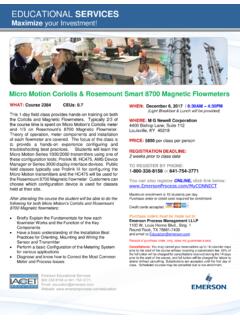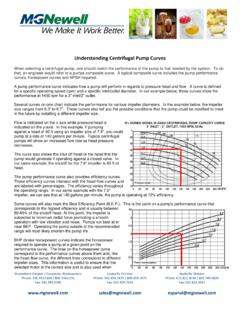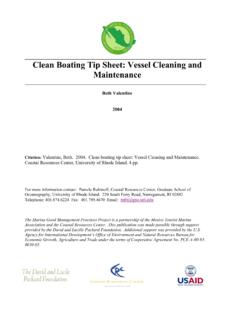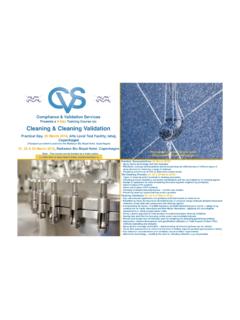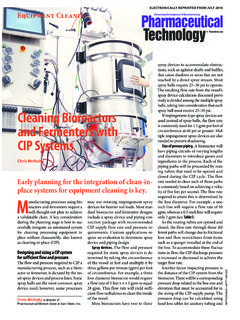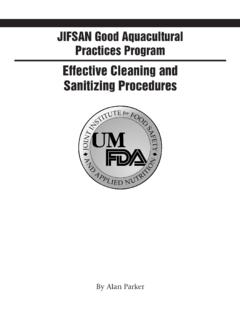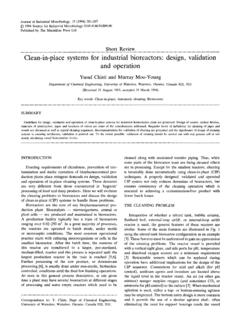Transcription of Cleaning Bioreactors and Fermenters with CIP …
1 Greensboro Division / Corporate Headquarters Phone: / Louisville Division Phone: / Nashville Division Phone: / Cleaning Bioreactors and Fermenters with CIP Systems Early planning for the integration of clean-in-place systems for equipment Cleaning is key. By Chris McNulty Pharmaceutical Technology Volume 40, Issue 7, pg 46 48 Manufacturing processes using Bioreactors and Fermenters require a well-thought-out plan to achieve a valid clean. A key consideration during the planning stage is how to successfully integrate an automated system for Cleaning processing equipment in place without disassembly, also known as Cleaning -in-place (CIP). Designing and sizing a CIP system for sufficient flow and pressure The flow and pressure required to CIP a manufacturing process, such as a bioreactor or fermenter, is dictated by the vessel spray devices and process lines.
2 Static spray balls are the most common spray device used; however, some processes may use rotating impingement spray devices for heavier soil loads. Most standard bioreactor and fermenter designs include a spray device and piping connection package with recommended CIP supply flow rate and pressure requirements. Custom applications require an evaluation to determine spray device and piping design. spray devices. The flow and pressure required for static spray devices is determined by taking the circumference of the vessel in feet and multiply it by three gallons per minute (gpm) per foot of circumference. For example, a three-foot diameter bioreactor would require a flow rate of 3 feet x x 3 gpm to equal 28 gpm. This flow rate will yield sufficient flow turbulence to clean the inside of the vessel .
3 Most Bioreactors have two to three spray devices to accommodate obstructions, such as agitator shafts and baffles, which cause shadows or areas that are not reached by a direct spray stream. Most spray balls require 25 30 psi to operate. The resulting flow rate from the vessel s spray device calculation discussed previously is divided among the multiple spray balls, taking into consideration that each spray ball must receive 25 30 psi. If impingement-type spray devices are used instead of spray balls, the flow rate is commonly sized for gpm per foot of circumference at 60 psi or greater. Multiple impingement spray devices are also needed to prevent shadowing. Size of process piping. A bioreactor will have piping circuits of varying lengths and diameters to introduce gasses and ingredients to the process.
4 Each of the piping paths will be proceeded by routing valves that need to be opened and closed during the CIP cycle. The flow rate needed to clean each of those paths is commonly based on achieving a velocity of five feet per second. The flow rate required to attain this is determined by the line diameter. For example, a one-inch line will require a flow rate of 10 gpm, whereas a line will require only 2 gpm (see Table I). Table I: Pipeline flow rate (velocity) chart. As the routing valves are opened and closed, the flow rate through those different paths will change due to frictional loss and flow restrictions from items such as a sparger installed at the end of the line. To accommodate these fluctuations in flow, the CIP discharge pressure is increased or decreased to achieve the target flow rate.
5 Another factor impacting pressure is the distance of the CIP system from the bioreactor . There will be a corresponding pressure drop related to the line size and elevation that must be accounted for in the sizing of the CIP supply pump. The pressure drop can be calculated using head loss tables for sanitary tubing and adding that pressure value to the pressure value needed at the bioreactor . Once the CIP solution is delivered to the bioreactor , it must be returned from the vessel outlet to the CIP system for recirculation or discharge to drain. It is necessary to incorporate a suitable return method in CIP planning, such as a sanitary liquid ring return pump or an eductor, both of which are capable of evacuating water and air to avoid pooling in the vessel , which is detrimental to Cleaning .
6 The liquid ring pump may be located on the CIP skid or adjacent to the bioreactor while the eductor is required to be located on the CIP skid. Both methods of return require a calculation of the return line head loss using the described method for the CIP supply line. Utilities, space, and facility layout When implementing a CIP system, one consideration is whether the process and location are best served by a portable or a stationary CIP system. Stationary CIP skids can be a one- or two-tank design. If speed of operation is important, a two-tank system with a separate solution and rinse tank will operate faster than a one-tank system. Portable CIP systems, while limited to one-tank designs, eliminate the need for permanent CIP supply and return piping by using flexible hoses.
7 All CIP systems require one or two water sources. Generally, a lower grade water is used for the pre-rinse and chemical wash steps while a product quality water ( , deionized water or water for injection) is used for the final rinse. Water utility flow requirements typically range from 10 to 30 gpm at 25 psi, depending on the CIP skid design (some specialized designs are not restricted by this). There are two common heating options available for CIP systems: Heat exchanger using plant steam. If only ambient water is available, or if there is a large surface area to heat, plant steam is used to provide indirect heating through a sanitary heat exchanger. Electric heater. If water can be brought into the system at 60 C or higher, electric heating elements can be used to effectively elevate and maintain the heat.
8 An electric heater is generally preferred for portable CIP systems to avoid the need for steam connections. Regardless of design, 3-phase electrical power source (208/230/460 VAC) is needed to operate the system. A 30- to 100-amp service connection is typically required depending on the available voltage, heating method, and pump motor sizing. A source of instrument air is needed to operate the air actuated devices located on the CIP skid. This includes valve actuators and air operated chemical pumps. An air source delivering 100 psi at 20 cubic feet per minute (CFM) is commonly specified. A suitable drain utility is also required, as drains need to be capable of handling 80 C water at a flow rate equal to the highest CIP circuit flow rate (some specialized designs are not restricted by this) and a pH range of 0 to 14.
9 Quenching methods are available for drain systems using PVC drain piping, which is generally limited to a maximum temperature of 60 C. Installations where a closed drain system is required, as opposed to a floor drain, require special consideration in the CIP system design to ensure the ability to drain and discharge into a line under pressure. While stationary systems only require these utilities to be local to the CIP skid, portable CIP installations will need utilities at each point of use. Either system design may be located in a utility or grey space in contrast to a controlled environment. Should this be the case, a hydrophobic vent filter should be installed on the CIP tank(s) to avoid potential contamination from the uncontrolled space during tank venting.
10 Both stationary and portable designs need to allow sufficient space for clearances to meet maintenance and local code requirements. Special consideration should be given to long-term maintenance requirements where space must be available for elastomer and pump seal replacement, removal of heat exchangers or electrical elements, and for access to all valves and instruments. The room classification must also be considered during CIP design. If the CIP system will be in a wash-down area, the electrical controls should be designed for a NEMA 4X location. Hazardous locations, such as Class I, DIV 1, require specialized electrical components and a purging system for the panel in order to meet the safety requirements. Finally, most bioreactor control systems require a means of communication with the CIP skid to signal valve cycling, agitator operation, alarm conditions, and cycle completion.

